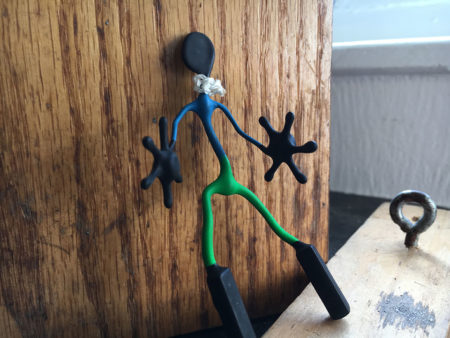Meet the Gremlin. Several years ago, Jim Bishop found him in a toolkit that came with a box of new particulate inorganic carbon (PIC) sensors used on the CTD Rosette. The figurine was a joke, apparently added to the box of spare parts by the sensor manufacturers.

The Gremlin. (Photo: Sarah Yang)
The Gremlin gets the blame when equipment and electronics don’t perform as expected, and the cause is unclear. For example, a key GPS system failed that stopped many of the ship’s scientific sensors, and it took hours of head scratching to figure out what had happened.
The Gremlin is meant to take the abuse of scientists frustrated when things go wrong. Its limbs can get stretched and he can even be thrown against the wall (that hasn’t happened during this trip). There are a lot of areas on a steel ship that the Gremlin’s magnetic legs can stick to.

(Photo: Jessica Kendall-Bar)
The two newest PIC sensors Bishop was testing began the cruise giving off wildly inconsistent readings, detecting unrealistically high levels of particulate inorganic carbon at depths that should have been “quiet,” among other oddities.
Bishop compared the readings of the new sensors with older, battle-tested versions used before, including “Old Faithful,” or PIC-001. The new sensors were designed to improve the long-term performance of the sensors that would allow them to be installed on the Carbon Flux Explorers, but some of the changes clearly led to new problems.
“The ocean is the best testbed,” said Bishop. “The reason we’re out here is to put these new designs and prototypes to the test. It’s really hard to reproduce the conditions of the ocean in the lab.”
It’s still not entirely clear what is throwing the new PIC sensors off, but systematically troubleshooting bugs is a standard part of sensor development.
“I probably have one gray hair for every problem I’ve had with a sensor,” said Bishop.

(Photo: Jessica Kendall-Bar)
The sensors are a relatively minor issue, though, and it’s clear that by this fourth day of testing, people have settled into their roles and a clear rhythm has developed. All able-bodied team members, including myself, have been trained to perform multiple jobs for this expedition, so we can more easily help each other out when it comes time to launch a CTD, filter water samples, communicate instructions to the winch operator, and fill in data for the laboratory logs.
“Even for people who have done this stuff before, including me, it takes a day or two to get oriented,” said Bishop. “In the beginning of every expedition, you’re teaching people who have never done these operations before. Things calm down after we get a number of launches under our belts. By the time we’re running smoothly, it’ll be time to get off the ship.”
In other news, the third Carbon Flux Explorer – CFE Cal 2 – was launched last night! And this time, there was clapping and cheers. We’ll find out how the new sampling system works when the robotic float is retrieved today.
Be sure to return to this site once the voyage ends (and more bandwidth is available) for more photos — and videos — from the research effort.
